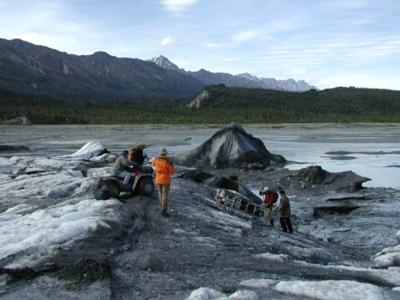3 August, 2000
August 3 , 2000
Matanuska Glacier, Alaska
The next dye tracing test has been put on hold as we wait for a shipment
of dye to arrive. With the quantity that we have on hand we decided to
let the others use whatís left. We plan to use much larger quantities in
our next series of tests and it made sense to wait. In the meantime I
continue to help Bob Bigl with the drilling team. Today was spent moving
the sleds over some relatively rough ice and rocks to a new drill site.
It was hard work as we had to chop lots of ice in some places to allow
the sleds to pass.
In addition to working on the dye tracing project and occasionally
helping people like Bob Bigl and Greg Baker I have helped Justin Pearce,
Ben Cashman and Josh Lawson with a variety of tasks dealing with the day
to day collection of water samples from a variety of vents. They were
hired by Cold Regions Research and Engineering Lab to collect these
samples during this summer melt season. They have been collecting
samples from North Vent, Little River, two of the Mammoth vents and also
from the main stream that drains South Vent. Samples of roughly 450
milliliter are taken in two hour intervals from each site. Back at camp
the actual volume of each sample is recorded and the sediment is
filtered from it. Using a special type of filter the sediment is
sandwiched between two pieces of filter paper which have been weighed in
advance of being used. These sandwiched sediment samples are then dried
in an oven and weighed again to determine the mass of sediment that each
water sample contained.
The mass and volume information can be used along with the flow rate of
the water at stream gauging stations to calculate the flux of sediment
out of the glacier. With this information the total mass of sediment for
the season can be determined. When applied over the surface area of the
glacier an approximate rate of erosion resulting in suspended sediment
can be estimated. Data collected in the past suggests an abrasion rate
of approximately one millimeter per year.
Recall from July 28 that this sediment called glacial flour is produced
by abrasion of the underlying rocks by the basal till layer. There are
other erosive processes at work on the bottom as well such as the
plucking of bedrock and the subsequent movement and breakup of those
larger pieces into smaller ones. By the time this material reaches the
terminus there is a variety of parcticle sizes from sediment up to small
pieces of stone.
In addition to his CRREL duties Justin Pearce is also collecting data
for his Masters thesis project. It is Justinís hypothesis that vents are
discharging more than just suspended sediment. Justinís research is
looking at the flow of the larger parcticles such as sand and small rocks
that may be discharging as well. Using a special type of sampling
devices he manages to catch these parcticles for further analysis. The
parcticles are sorted by size and the total mass and the mass of each
parcticle size is recorded. I have seen Justin wading waist deep into
these rushing, cold waters to collect his samples. Heís managed to only
fall in once and he gives a good first hand account of how cold these
meltwaters are.
At a later date he will have access to the discharge records of the
streams draining the glacier. By using similar analysis techniques he
will hopefully yield similar sorts of conclusions that were made about
suspended sediment erosion. Heís hoping to be able to correlate vent
discharge rates with suspended sediment flow and the larger parcticles
that heís studying.
Marvin Giesting

Bob Bigl carefully maneuvers one of the sleds over an ice ridge.

Occasionally it is necessary to use the winch on the ATV to get up and over the ridges. At the top the sled must be carefully balanced and braced into a locked position while the hitch is reattached.
Contact the TEA in the field at
.
If you cannot connect through your browser, copy the
TEA's e-mail address in the "To:" line of
your favorite e-mail package.
|
